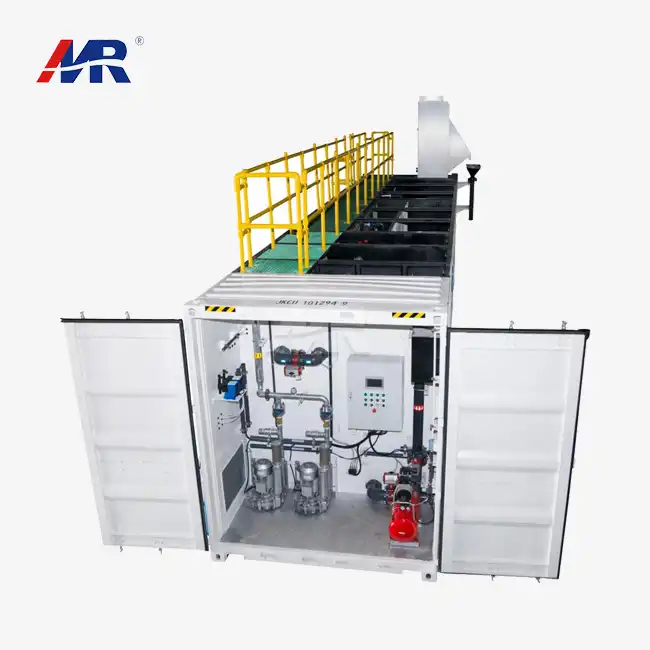Space-saving Advantages of MBR Systems
One of the most significant benefits of MBR technology is its compact footprint, making it an ideal solution for facilities with limited space or those looking to expand their treatment capacity without increasing their physical plant size. Traditional wastewater treatment plants often require large settling tanks and clarifiers, which can occupy substantial areas. In contrast, MBR systems integrate the biological treatment and solid-liquid separation processes into a single, compact unit.
Footprint Reduction and Land Use Efficiency
The space-saving nature of MBR systems can lead to significant reductions in land requirements, sometimes up to 50% compared to conventional activated sludge systems. This compact design is particularly advantageous in urban areas or industrial sites where land is at a premium. The reduced footprint also translates to lower construction costs and fewer infrastructure requirements, making MBR an attractive option for both new installations and facility upgrades. Partnering with a trusted China MBR wastewater treatment plant factory ensures access to cutting-edge designs that maximize space efficiency and long-term performance.
Modular Design for Scalability
MBR systems offer excellent scalability due to their modular design. Facilities can easily expand their treatment capacity by adding membrane modules without significantly altering the existing infrastructure. This flexibility allows for phased implementation and future expansions, making it easier for facilities to adapt to changing wastewater treatment needs over time.
Enhanced Effluent Quality: Meeting Stringent Regulations
As environmental regulations become increasingly stringent, facilities across various industries are under pressure to improve their wastewater treatment processes. MBR wastewater treatment plants excel in producing high-quality effluent that consistently meets and often exceeds regulatory standards.
Superior Filtration and Contaminant Removal
The heart of an MBR system lies in its advanced membrane technology, which provides exceptional filtration capabilities. These membranes typically have pore sizes ranging from 0.03 to 0.4 micrometers, allowing for the removal of not only suspended solids but also many bacteria and some viruses. This level of filtration results in effluent quality that is often superior to that produced by conventional treatment methods.
Consistent Performance Under Varying Conditions
MBR frameworks illustrate momentous versatility to variances in influent quality and amount. The natural treatment prepare combined with layer filtration guarantees steady execution indeed amid top loads or when confronting challenging wastewater compositions. This solidness is especially profitable for mechanical offices with variable wastewater characteristics or regions managing with regular changes in population.
Long-term Cost Benefits of MBR Implementation
While the initial capital investment for an MBR system may be higher than traditional treatment methods, the long-term cost benefits often outweigh the upfront expenses. Facilities implementing MBR technology can realize significant savings over the life cycle of the system.
Reduced Operating Costs
MBR systems typically require less chemical usage compared to conventional treatment processes. The high-quality effluent produced by MBR plants also opens up opportunities for water reuse, potentially reducing overall water consumption and associated costs. Additionally, the automated nature of MBR systems can lead to reduced labor requirements for daily operations. Partnering with a trusted China MBR wastewater treatment plant factory ensures access to advanced, cost-effective, and reliable solutions that maximize both performance and sustainability.
Lower Sludge Production and Disposal Costs
MBR technology is known for its ability to operate at higher mixed liquor suspended solids (MLSS) concentrations, resulting in lower sludge production compared to conventional activated sludge systems. This reduction in sludge volume translates to decreased disposal costs and a smaller environmental footprint associated with sludge management.
Energy Efficiency and Sustainability
While MBR systems do require energy for membrane aeration and filtration, advancements in membrane technology and process optimization have led to improved energy efficiency. Some modern MBR designs incorporate energy recovery systems and smart control algorithms to further reduce overall energy consumption. The potential for water reuse also contributes to the sustainability profile of MBR technology, aligning with growing corporate and municipal sustainability goals.
Conclusion
MBR wastewater treatment plants offer a compelling arrangement for offices looking for to update their water treatment capabilities. The space-saving plan, predominant profluent quality, and long-term taken a toll benefits make MBR innovation an appealing choice over different businesses. As water shortage and natural directions proceed to shape the future of wastewater administration, MBR frameworks stand out as a forward-thinking and productive approach to assembly these challenges head-on.
Expert MBR Wastewater Treatment Plant Solutions | Morui
Ready to transform your wastewater treatment process with advanced MBR technology? Guangdong Morui Environmental Technology Co., Ltd. is your trusted partner for high-quality, efficient MBR wastewater treatment plant solutions. Our experienced team is prepared to guide you through every step of the implementation process, from initial consultation to ongoing support. Don't hesitate to reach out and discover how our innovative MBR systems can revolutionize your facility's water management. Contact us today at benson@guangdongmorui.com to schedule a consultation and take the first step towards a more sustainable and efficient wastewater treatment future.
References
1. Zhang, Q., et al. (2021). "Advances in membrane bioreactor technology for wastewater treatment and reuse." Journal of Environmental Management, 282, 111959.
2. Judd, S. (2016). "The status of industrial and municipal effluent treatment with membrane bioreactor technology." Chemical Engineering Journal, 305, 37-45.
3. Meng, F., et al. (2017). "Recent advances in membrane bioreactors (MBRs): Membrane fouling and membrane material." Water Research, 128, 255-269.
4. Krzeminski, P., et al. (2017). "The strength of membrane bioreactors in urban wastewater treatment: A review." Environmental Technology & Innovation, 8, 272-288.
5. Wan, J., et al. (2018). "Simultaneous carbon and nitrogen removal using an oxic/anoxic-biocathode microbial fuel cells coupled system." Bioresource Technology, 247, 345-353.
6. Lin, H., et al. (2020). "Membrane bioreactors for industrial wastewater treatment: A critical review." Critical Reviews in Environmental Science and Technology, 50(24), 2576-2621.

_1745823981883.webp)


